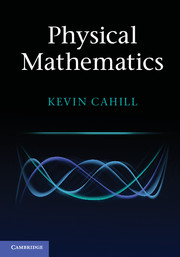Book contents
- Frontmatter
- Contents
- Preface
- 1 Linear algebra
- 2 Fourier series
- 3 Fourier and Laplace transforms
- 4 Infinite series
- 5 Complex-variable theory
- 6 Differential equations
- 7 Integral equations
- 8 Legendre functions
- 9 Bessel functions
- 10 Group theory
- 11 Tensors and local symmetries
- 12 Forms
- 13 Probability and statistics
- 14 Monte Carlo methods
- 15 Functional derivatives
- 16 Path integrals
- 17 The renormalization group
- 18 Chaos and fractals
- 19 Strings
- References
- Index
11 - Tensors and local symmetries
- Frontmatter
- Contents
- Preface
- 1 Linear algebra
- 2 Fourier series
- 3 Fourier and Laplace transforms
- 4 Infinite series
- 5 Complex-variable theory
- 6 Differential equations
- 7 Integral equations
- 8 Legendre functions
- 9 Bessel functions
- 10 Group theory
- 11 Tensors and local symmetries
- 12 Forms
- 13 Probability and statistics
- 14 Monte Carlo methods
- 15 Functional derivatives
- 16 Path integrals
- 17 The renormalization group
- 18 Chaos and fractals
- 19 Strings
- References
- Index
Summary
Points and coordinates
A point on a curved surface or in a curved space also is a point in a higher-dimensional flat space called an embedding space. For instance, a point on a sphere also is a point in three-dimensional euclidean space and in fourdimensional space-time. One always can add extra dimensions, but it's simpler to use as few as possible, three in the case of a sphere.
On a sufficiently small scale, any reasonably smooth space locally looks like n-dimensional euclidean space. Such a space is called a manifold. Incidentally, according to Whitney's embedding theorem, every n-dimensional connected, smooth manifold can be embedded in 2n-dimensional euclidean space ℝ2n. So the embedding space for such spaces in general relativity has no more than eight dimensions.
We use coordinates to label points. For example, we can choose a polar axis and a meridian and label a point on the sphere by its polar and azimuthal angles (θ, ϕ) with respect to that axis and meridian. If we use a different axis and meridian, then the coordinates (θ′, ϕ′) for the same point will change. Points are physical, coordinates are metaphysical. When we change our system of coordinates, the points don't change, but their coordinates do.
Most points p have unique coordinates xi (p) and x′i (p) in their coordinate systems. For instance, polar coordinates (θ, ϕ) are unique for all points on a sphere – except the north and south poles which are labeled by θ = 0 and θ = π and all 0 ≤ ϕ < 2π.
- Type
- Chapter
- Information
- Physical Mathematics , pp. 400 - 478Publisher: Cambridge University PressPrint publication year: 2013



